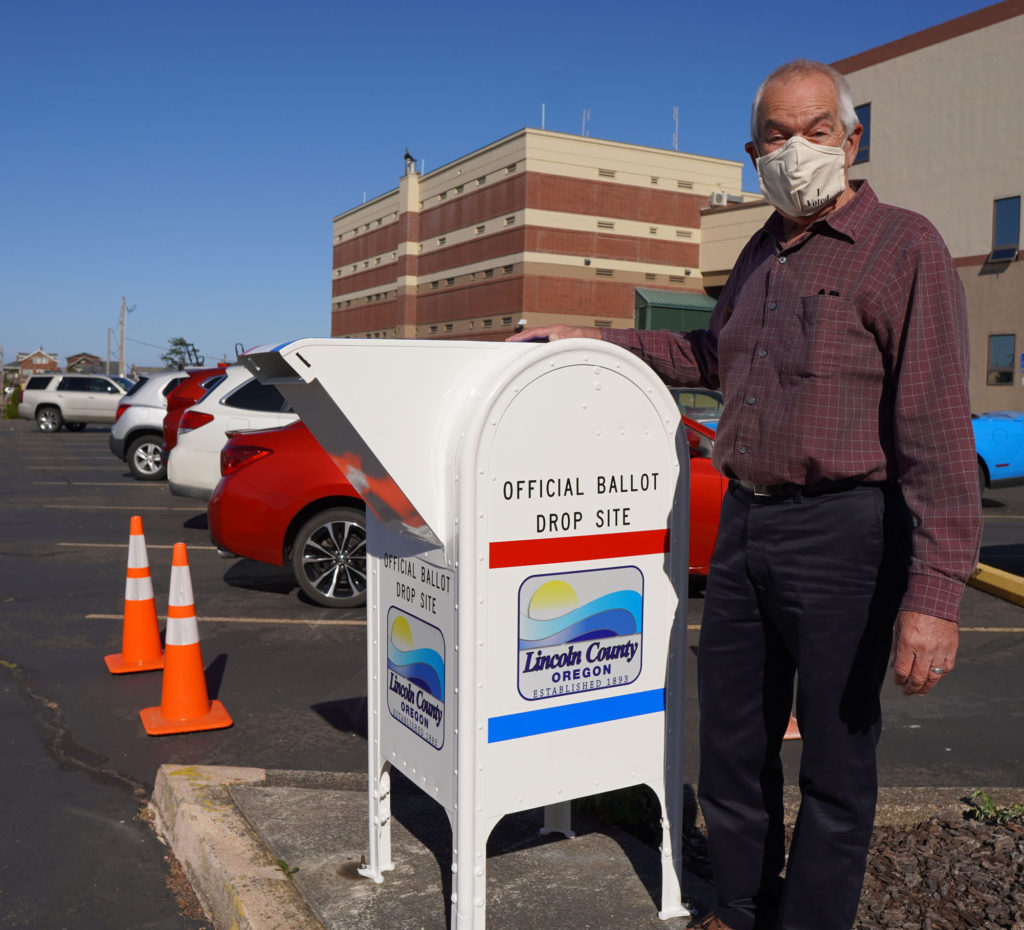
By QUINTON SMITH/YachatsNews.com and JAKE THOMAS/The Salem Reporter
Lincoln County has mailed out a record 39,065 ballots for the Nov. 3 election and voters should be receiving them Friday or this weekend.
“That’s the highest we’ve ever been,” Lincoln County Clerk Dana Jenkins told YachatsNews.com. “We’ve been steadily increasing but we’ve seen a huge increase in registrations the past three months.”

More than 39,000 registered voters in a county with a population of just under 50,000 is a big feat. “We’re getting close to registering everybody who’s eligible,” Jenkins said.
Now all voters have to do is fill out the ballot, be sure to sign it, and either drop it in the mail – this year posted is free – or take it to special drop boxes outside all city halls and the Lincoln County courthouse.
Jenkins estimates general election turnout – always higher when selecting a president – will be 80 percent. That’s the same as it was in November 2016, but when there were 7,000 fewer registered voters.
“That’s about as high as we go,” he said.
The county clerk has added special drop boxes outside three city halls this year – Yachats, Depoe Bay and Siletz. Previously in Yachats, voters had to take them inside to a utility bill payment box. Now there’s a special drive-by box on the north side of the 501 Building in Yachats.

Each day an election division employee will pick up the ballots and take them to the county courthouse in Newport. This election, Jenkins estimates that half of voters will drop off their ballots, the other half will put them in the mail.
If mailed, Jenkins is advising voters do that by the end of the day Oct. 27, just to be extra sure – a full week – that ballots reach the county elections division by 8 p.m. Nov. 3.
But state election officials and U.S. Postal Service managers in Oregon don’t expect any problems – the state has been conducting mail elections for 20 years without major issues.
“We’ve bee doing this for 20 years, so it’s a well-oiled machine,” Jenkins said.
Here’s what happens once the ballot reached the county courthouse:
- The ballot is logged in and the voter’s signature on the envelope is compared with the signature on the person’s voter registration card.
- If the signatures are not a good match, an elections employee mails a letter with a new registration card to the voter and asks them to submit a new signature.
- The same occurs if a ballot is returned with no signature.
- Once the signature is verified, the ballot is stamped with the date it arrived and filed for eventual counting.
- On Oct 27, seven days before the Nov. 3 election, county elections employees take ballots out of their envelopes and get them ready to count. Once counted, the individual tallies are held inside computers until 8 p.m. Tuesday, Nov. 3 when the first results are released. Vote results released later that night are from ballots received the last two days.
- Voters can track the progress of their ballots by going to MyVote on the Oregon Secretary of State’s website. Lincoln County voters can also call the county elections division at 541-265-4131.
For the election, the clerk’s office added 14 temporary but experienced staff to help with county ballot, Jenkins said, including a few additional this fall “because we expect a big turnout.”
Oregon, USPS officials see no election problems
Despite the coronavirus pandemic, voters displaced by September wildfires and concerns about mail slowdowns before the election, Oregon elections director Steve Trout said that this year’s election is, surprisingly, “business as usual.” Trout is overseeing his ninth election in Oregon.
“We’re not seeing any changes or differences,” said Trout, speaking at a press event last week in Salem. “The timelines that we’re working on are exactly the same as we did for the primary and exactly the same as we did in 2018 or 2012 or any previous election.”
Trout, along with officials from the U.S. Postal Service, gathered at the west Salem Post Office to declare that the mail service is functioning as it should and Oregon voters can be confident that their ballot will be delivered.
Bill Schwartz, the manager for the postal service district that includes all of Oregon and southern Washington, said that the number of ballots expected is a small volume of mail that can be easily processed.
He said that every day the district processes about seven or eight million pieces of mail. This election, he expects to process about 1.1 million to 1.3 million ballots from Oregon voters that will come in over an 18 to 21-day period.
Schwartz said processing involves putting the mail through a machine that sorts them to the right address by using a barcode. From there, it’s passed along to the mail carriers who deliver it, he said.
“Even if we received them all in one day, we have the processing capability to process them using all of the equipment in 30 minutes,” he said. “Using half the equipment, one hour.”
Critics have accused President Donald Trump, a critic of mail-in voting, of deliberately undermining the postal service. Last month, postal workers rallied in Salem and elsewhere to push back against funding cuts and service delays.
Valerie Castillo, president of Branch 347 of the National Association of Letter Carriers, told the Salem Reporter that she agreed with the assessment given by Schwartz and that mail delivery in Oregon won’t be affected. But she said concerns about other parts of the country remain.
Schwartz said that the pandemic has increased the number of parcels going through the district. But he said that calls for people to avoid using the mail in order to clear up capacity for ballots is a based on a “fallacy.”
As each election season picks up, the U.S. Postal Service prepares staff for the increase in campaign mailers and voters’ pamphlets. Trout said that letter carriers are also directed to look out for undeliverable mail so that elections officials can be notified and reach out to the voter to notify them to update their address.
The postal service will not forward ballots along with other mails, which is a security feature of Oregon’s election system, said Trout.
Trout said his main concern is disinformation swirling that stems from lawsuits in other states trying to quickly adopt mail-in voting procedures in response to the pandemic. However, voting in Oregon remains the same.
“That’s good for the voters because what you’ve done in the past is what you can do this time, and you’ll be fine,” he said.


